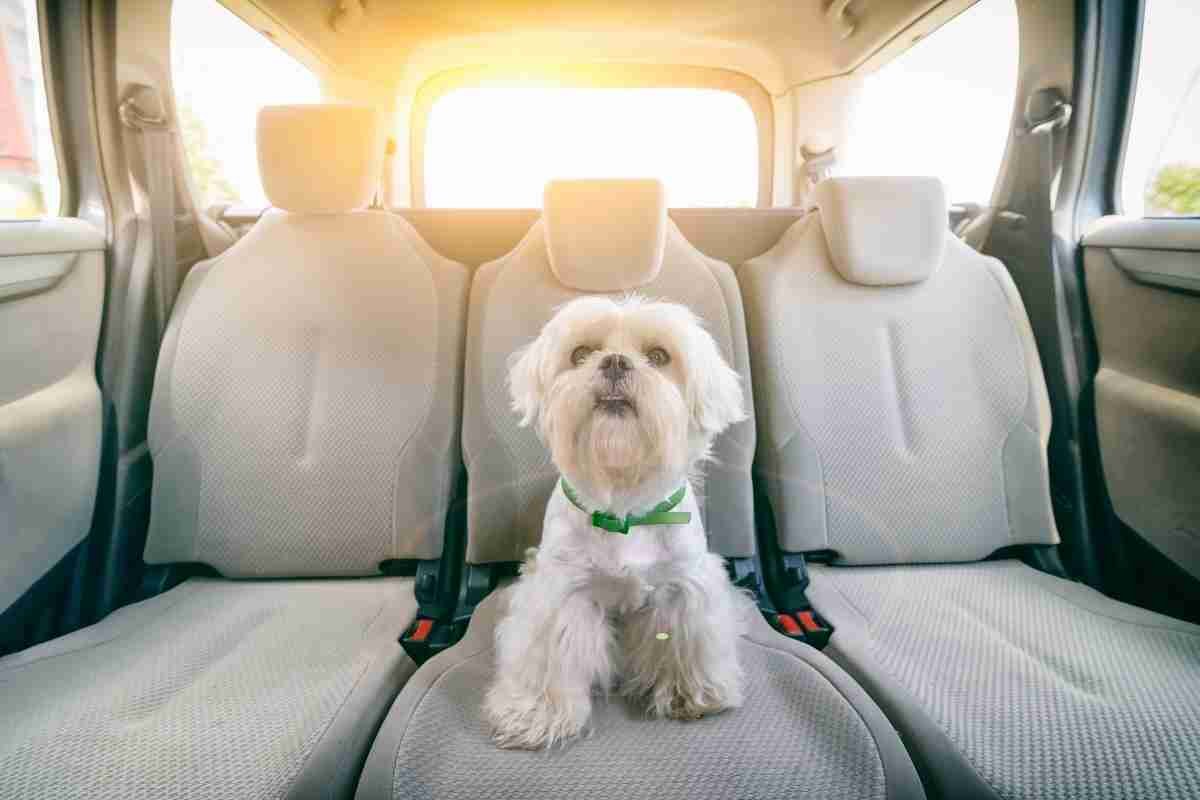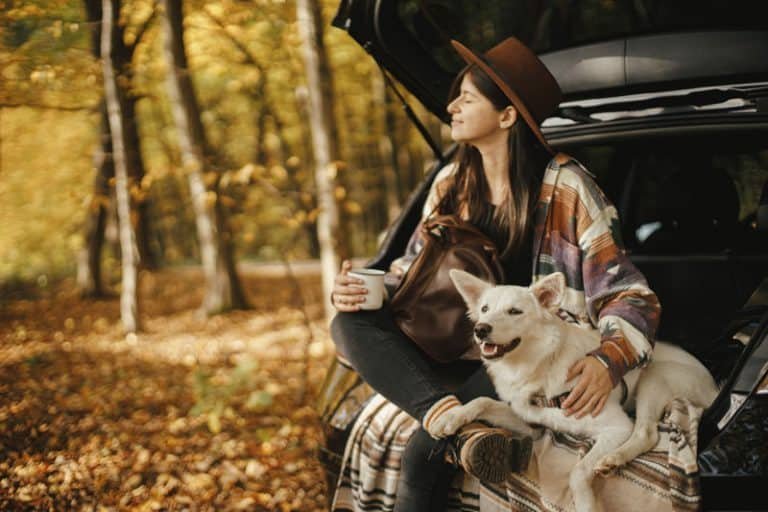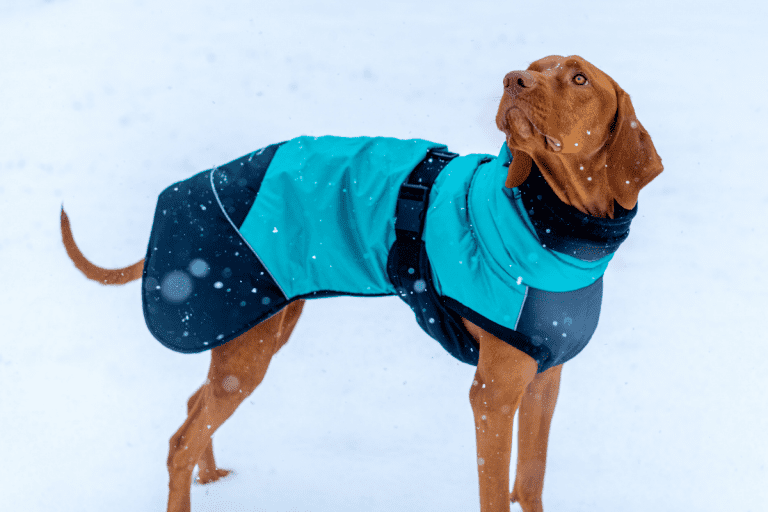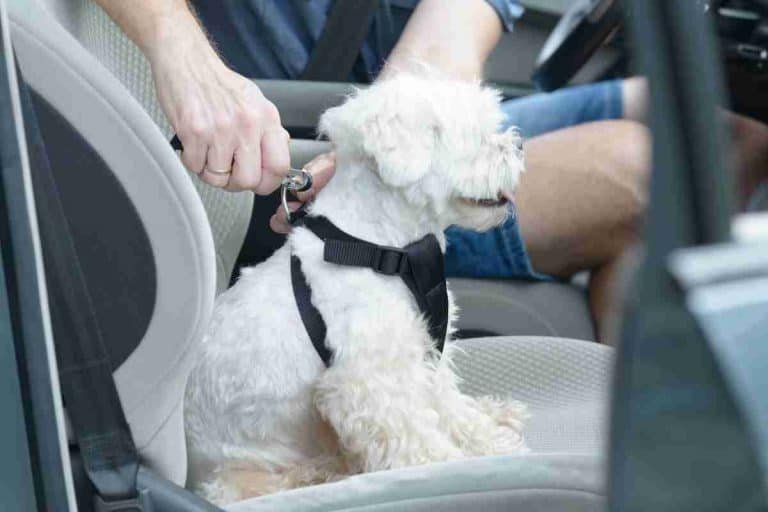6 Safe Ways to Transport a Puppy in a Car Without a Crate
Last Updated on October 30, 2025
6 Safe Ways to Transport a Puppy in a Car Without a Crate start with proven, crash-tested setups. Crate-free travel stays safe when restraint, anchors, and fit all align. Options include seatbelt-style harnesses, small-puppy booster seats, backseat hammocks, secured soft carriers, cargo-area tethers, and hard-mounted systems. Each method uses seatbelt paths or LATCH/ISOFIX points, not a collar clip.
Readers gain quick checklists, harness-fit steps, and legal pointers that reduce risk. Training tips, motion-sickness fixes, and packing essentials keep trips calm. Owners can match each method to puppy size, temperament, vehicle, and distance. The following sections present practical setups that protect passengers and pets.
Safety basics before you drive with a puppy
Puppy travel starts with basic preparation. Owners must confirm vaccinations, secure visible ID tags, and pack a small first-aid kit, water, and a travel bowl. Conditioning the puppy with short practice rides reduces stress and improves compliance.
Choose a secure spot in the back seat and keep the puppy off the driver’s lap. Remove loose objects that can become projectiles. Set vehicle temperature to a comfortable level and never leave the puppy unattended in a parked car.
Train the puppy to accept a harness and brief tethering at home before using it on the road. Use non-slip seat covers or a booster that prevents sliding. Schedule regular stops for elimination, water, and short walks on longer trips. For practical gear suggestions and packing checklists, see essential dog travel tips and gear for road trips.
Owners should practice fitting and fastening safety gear at home. Comfortable, well-fitted equipment reduces movement and makes trips calmer for both driver and puppy.
Why unrestrained puppies endanger pets and people
An unrestrained puppy transforms into a hazard during sudden braking, swerves, or collisions. Even at moderate speeds, a small animal can become a high-speed projectile capable of severe injury to itself and vehicle occupants. Puppies moving around the cabin also distract drivers, increasing crash risk.
Airbags pose a lethal threat to small dogs sitting in the front seat. Laps do not provide reliable protection; a lap-held puppy can be crushed or thrown. Unrestrained animals may block pedals, interfere with gear shifts, or obstruct the driver’s view.
Beyond crash dynamics, unrestrained puppies can slip out open doors during stops. Motion-sick puppies that vomit or whine may force unscheduled stops and raise stress for everyone. For a focused discussion about where dogs should and should not ride inside a vehicle, consult are dogs allowed to travel in the footwell of a car.
Restraining the puppy in the rear seat with appropriate gear minimizes these risks and preserves safety for people and pets.
Crash-tested gear vs. unverified products — what to look for
Not all pet restraints perform the same in a crash. Look first for independent crash-test certification. Organizations such as the Center for Pet Safety (CPS) publish test results and list approved harnesses and crates. Certified products demonstrably reduce peak forces in impact tests.
Key features to check:
- Attachment method: hardware that connects to the vehicle’s seat-belt path or anchor points, not just a leash clip.
- Material and hardware: steel or reinforced buckles, heavy-duty webbing, and tested stitching.
- Tether length: short enough to prevent the puppy from reaching the front seats, yet long enough for comfortable posture.
- Fit adjustability: multiple adjustment points to avoid submarining under forces.
Avoid cheap, untested harnesses with D-ring clips that were not designed for crash loads. Even if the article focuses on crates, product testing methods overlap; readers can learn more about tested containment options in the best dog crates for car travel in 2023 review. Replace worn straps, follow manufacturer fit guides, and register products for recall notices.
Legal rules, local regulations and insurance implications
Laws about transporting animals vary by state and country. Some jurisdictions classify an unrestrained pet as a distraction and apply distracted-driving penalties. Others ban animals in the driver’s lap or mandate secure restraint. Commercial drivers face stricter requirements.
Insurance carriers may consider an unrestrained pet a contributing factor in an accident claim. That stance can affect liability assessments and payouts if a pet caused driver distraction. Documenting the use of certified restraints and keeping receipts can help during claim reviews.
When planning travel, verify local statutes through the state DMV or police website. Contact the vehicle insurer to confirm policy nuances related to pet-caused incidents. For fleet or long-distance travel, consider written company policies that require specific restraint types and maintenance records.
A brief call to the insurer and a check of local rules before a long trip prevents surprises and protects both owner and puppy.
How to choose the best non-crate option for your puppy
Choosing a non-crate travel option requires a clear match between the puppy’s needs and the chosen method. Start by listing trip length, typical car type, and the puppy’s activity level. Short city runs allow more flexible solutions than long highway trips. For safety, prioritize options that attach to the vehicle’s restraint points or seatbelt system. Evaluate the puppy’s comfort during short trial drives before committing to longer trips. Make a checklist: size and weight limits, expected motion tolerance, available anchor points, and ease of cleaning. Consider how quickly the puppy matures. A solution that fits a 10-week-old may become unsafe or cramped at six months.
Owners should compare practical details such as installation time, portability, and whether the product concentrates stress on a single attachment point. For wider context on travel gear and practical items to bring, consult Essential dog travel tips and gear for road trips. Try each option during low-stress drives. If the puppy resists or shows distress, switch methods. A brief, structured trial prevents mistakes on longer journeys. As a CTA, test-fit the chosen product at home and record adjustments needed for a secure, repeatable install.
Match the method to size, age and temperament
Matching method to size, age and temperament reduces risk and stress. Small, calm breeds often travel well in a padded booster or vehicle hammock that creates a den-like space. Very young or high-energy puppies benefit from more restrictive yet comfortable options, such as a properly fitted booster seat with harness attachment, which limits excessive movement while allowing visibility. Large-breed puppies that cannot yet sit stably require restraint solutions that support the body without forcing unnatural posture.
Temperament matters more than breed. An anxious puppy may do better in a low-visibility option that limits external stimuli. A curious, active pup needs a method that prevents climbing while permitting weight distribution changes. For tips on reducing motion sickness and training a puppy to accept car time, see the guide on making rides enjoyable for motion-sensitive pups at No more doggie dramas: how to make car rides enjoyable for your motion sick pup. Fit and finish matter: measure chest girth, weight, and sitting height to pick the right product size.
When to prefer a tethered solution vs. containment
Choose a tethered solution when the primary goal is to keep the puppy near a seating position and prevent roaming. Tethers, when used with a crash-tested harness and anchored to a seatbelt or ISOLOK point, reduce forward movement during sudden stops. They suit short drives and puppies that already tolerate restraint. Avoid tethers for unsupervised puppies or long trips, since restricted motion can cause stress or injury over time.
Containment options—booster seats, seat hammocks, or vehicle dividers—work better when the puppy needs a stable, cushioned area to lie down. Containment reduces distraction for the driver and spreads impact forces across a larger surface. Use containment for longer journeys, multi-hour stops, or when multiple pets travel together. For practical tethering methods and safe anchor techniques, review real-world securing strategies at How to secure a dog in car with leash. Always combine a tether with a crash-tested harness. Never attach a tether to a collar.
Budget, vehicle type and product durability considerations
Budget decisions should balance upfront cost against longevity and safety. Cheap harnesses and boosters often use thin hardware and stitching that fail under stress. Invest in products that list weight ratings, strong buckles, and reinforced attachment points. Consider washable materials and removable liners for hygiene. Evaluate how the product integrates with the vehicle’s layout—rear bench, bucket seats, or SUVs with cargo areas each need different solutions.
Vehicle type determines anchor options. Modern cars with ISOFIX or LATCH points enable secure attachments. Older vehicles may require seatbelt-only installations; ensure any chosen product clearly documents this method. Durability matters for active puppies; look for abrasion-resistant fabrics and corrosion-resistant hardware. For side-by-side comparisons of travel containment and durability features, reference product reviews such as Best dog crates for car travel in 2023: a comprehensive review, which highlights construction and mounting insights useful even when choosing non-crate gear. As a CTA, prioritize tested hardware and inspect all straps and buckles before every trip.
Six safe methods to transport a puppy without a crate
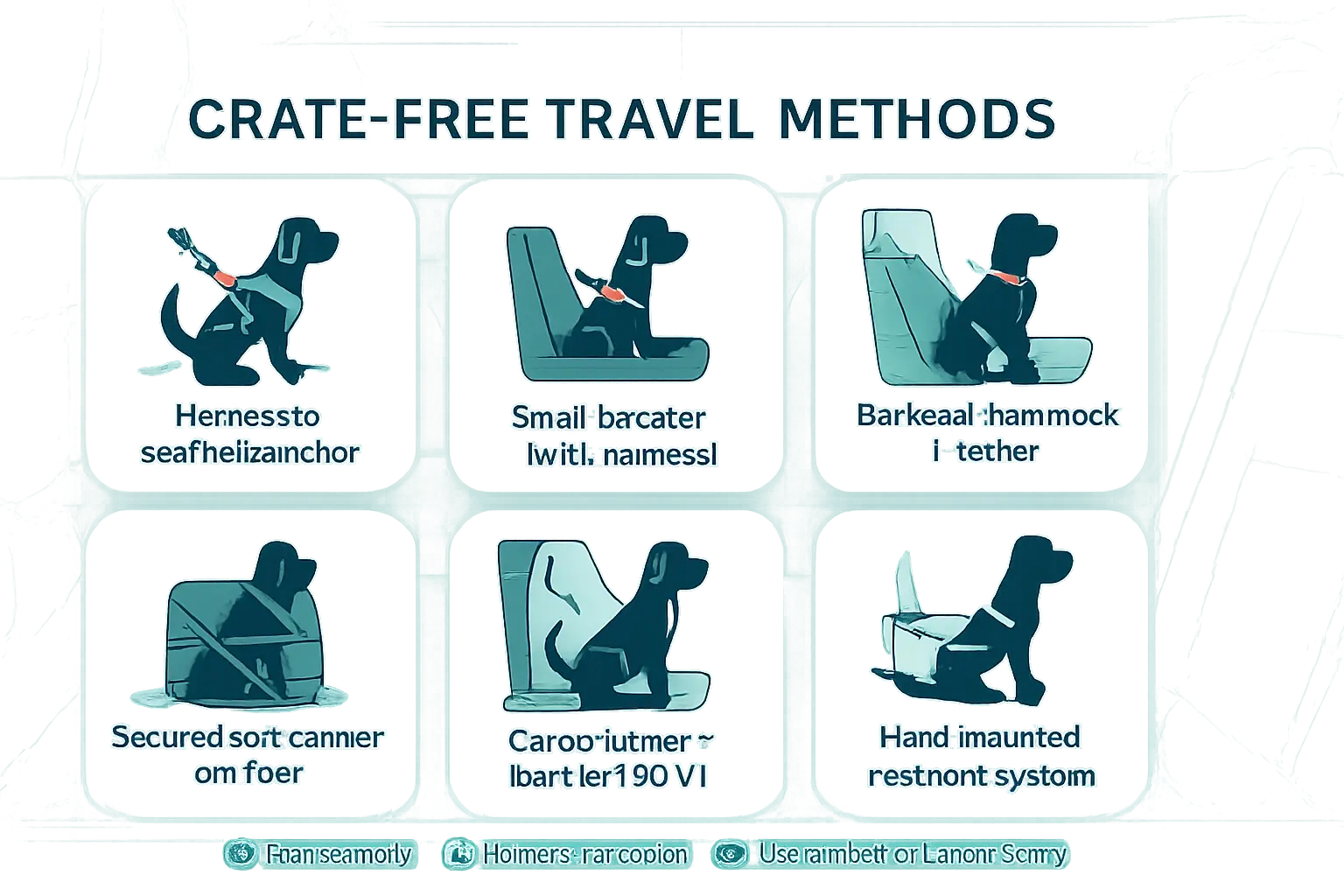
Puppy owners need practical, safety-focused options when a crate isn’t available or suitable. Choices depend on puppy size, temperament, vehicle type and trip length. Each method below prioritizes restraint, comfort and clear attachment points to reduce injury risk during sudden stops. Owners should confirm gear fit, test short drives, and follow vehicle manufacturer anchor recommendations. For broader gear and road-trip planning, see essential dog travel tips and gear for road trips.
Seatbelt-style travel harness attached to the vehicle’s anchor
A seatbelt-style harness secures a puppy directly to the vehicle’s existing anchor points. Choose a harness labeled for crash testing or designed for automotive use. Fit the harness snugly using the two-finger rule under the chest strap; a loose harness allows dangerous movement. Attach the tether to the vehicle’s lower anchor or a seatbelt buckle adapter, not a collar.
Key fit and use steps:
- Confirm the harness size by measuring girth and neck.
- Adjust straps so the puppy cannot wriggle free.
- Secure the tether to an appropriate anchor and remove excess slack.
- Perform a short test drive to check comfort and restraint.
For guidance on securing canine restraints and anchor selection, consult how to secure a dog in car with leash.
Small-puppy car booster or pet car seat (proper installation tips)
A booster seat elevates a small puppy so it sees out the window while staying contained. Use only models with integrated tethers that connect to a travel harness. Place the booster on the back seat and route the vehicle seatbelt through the manufacturer’s belt path. Avoid using a restraining collar tether inside the booster.
Installation checklist:
- Confirm booster weight limits and internal tether compatibility.
- Attach the booster to the seat firmly with the vehicle belt or anchor strap.
- Clip the puppy into the internal tether after the harness fits correctly.
- Provide a low-profile pad to reduce sliding and add stability.
See tested travel gear reviews like the best dog crates for car travel page for selecting secure, vehicle-rated products.
Hammock-style backseat setup with harness attachment for restraint
A hammock-style cover transforms the backseat into a contained platform and protects upholstery. Select hammocks with reinforced anchor loops and integrated seatbelt openings. Attach the puppy’s harness tether to the seatbelt or lower anchor through the hammock’s access point.
Use tips for safety and comfort:
- Confirm the hammock’s edge prevents the puppy from falling into footwells.
- Anchor the hammock to headrests and lower anchors for stability.
- Use short tethers to limit forward motion while allowing natural posture.
- Break in the setup with short rides to reduce anxiety.
For related ideas on hammock use with dogs, consult hammock camping tips, which cover stability and comfort considerations applicable to vehicle hammocks.
Secured soft carrier or travel bag placed on the vehicle floor
Soft carriers make sense for very small or nervous puppies. Placing the carrier on the vehicle floor keeps its center of gravity low. Stabilize the carrier with a seatbelt threaded around it or by wedging against the seat base. Ensure the carrier vents well and the puppy can lie flat.
Practical pointers:
- Pick a carrier sized for the puppy to stand and turn.
- Anchor the carrier using a belt through handles or a tether to a lower anchor.
- Use a non-slip mat underneath to prevent sliding.
- Remove front-seat placement when an airbag could deploy.
For techniques on securing soft-sided transport in vehicles, review how to secure a cat carrier in car.
Cargo-area containment with a harness tether (SUVs and wagons)
For larger puppies in SUVs or wagons, the cargo area provides space while allowing secure tethering. Use a harness tied to factory cargo anchors or to a professionally installed D-ring. Combine a low-profile divider or barrier to prevent the puppy from being thrown forward.
Best practices:
- Install a cargo barrier rated for canine use to limit forward movement.
- Use a tether length that prevents jumping but allows comfortable standing.
- Secure loose cargo to prevent projectiles during sudden stops.
- Ensure ventilation and climate control reach the cargo area.
For step-by-step tips about securing dogs in vehicle cargo areas, see how to secure a dog in the cargo area of SUV.
Certified hard-mounted restraint systems and professional tethers
Hard-mounted restraints attach directly to a vehicle’s chassis and offer the highest protection. Professional systems include bolted anchors, crash-rated tethers and mounting plates. Owners should choose systems with independent testing or certification and follow vehicle and manufacturer installation instructions.
Selection and installation advice:
- Confirm crash-test certification and weight ratings before purchase.
- Hire a professional installer for hard-mount anchors when required.
- Inspect mounting hardware periodically for corrosion and tightness.
- Use a crash-tested harness; do not attach to a collar.
For practical methods to secure canine transport gear in vehicles, consult resources such as ways to secure a dog crate in car. Owners planning frequent travel should inspect gear regularly and consult a certified installer before long trips.
Step-by-step: fitting and securing a puppy travel harness
The section supports the guide 6 Safe Ways to Transport a Puppy in a Car Without a Crate by walking through harness fit, attachment and on-road checks. A properly fitted harness limits movement without causing pressure on the neck or spine. Follow measured steps to reduce injury risk and stress.
Measuring for fit and choosing the right harness type
Measure neck circumference and the widest part of the chest (girth) while the puppy stands. Compare measurements to the manufacturer size chart. Choose from these common types:
- Vest/step-in: distributes force across the chest. Good for small breeds and escape artists.
- H-style: lightweight and adjustable but concentrates force on straps.
- Crash-tested harness: designed to manage forces in a collision. Prefer these for highway travel.
Select breathable materials, solid metal hardware, and multiple adjustment points. If the puppy sits near the front passenger, prioritize a harness with a wide chest plate and padding to prevent chafing.
Correct attachment points, strap checks and safety tests
Attach the harness to the vehicle using the seatbelt or the vehicle’s lower anchor points. Clip to the harness D-ring on the back, never to a collar. Perform these checks:
- Strap tension: allow two fingers between strap and puppy at major contact points.
- Buckles and stitching: inspect for cracks, frays or bent metal.
- Tug test: give a firm, controlled pull to confirm hardware holds and clasp won’t slip.
Periodically recheck straps during long trips; fabrics stretch with use.
Trial rides and how to verify a secure, comfortable fit
Begin with short drives around the block. Observe the puppy’s posture, breathing and movement. Signs of an improper fit include rubbing, difficulty lying down, or the harness riding up toward the neck. Gradually increase trip length once the puppy stays calm for 10–15 minutes. If the puppy resists or slips free, stop and readjust. For extra guidance on vehicle attachment methods, see this resource on how to secure a dog in car with leash.
CTA: Purchase a crash-tested harness and run a parking-lot trial before any long journey.
Preparing and training your puppy for car travel
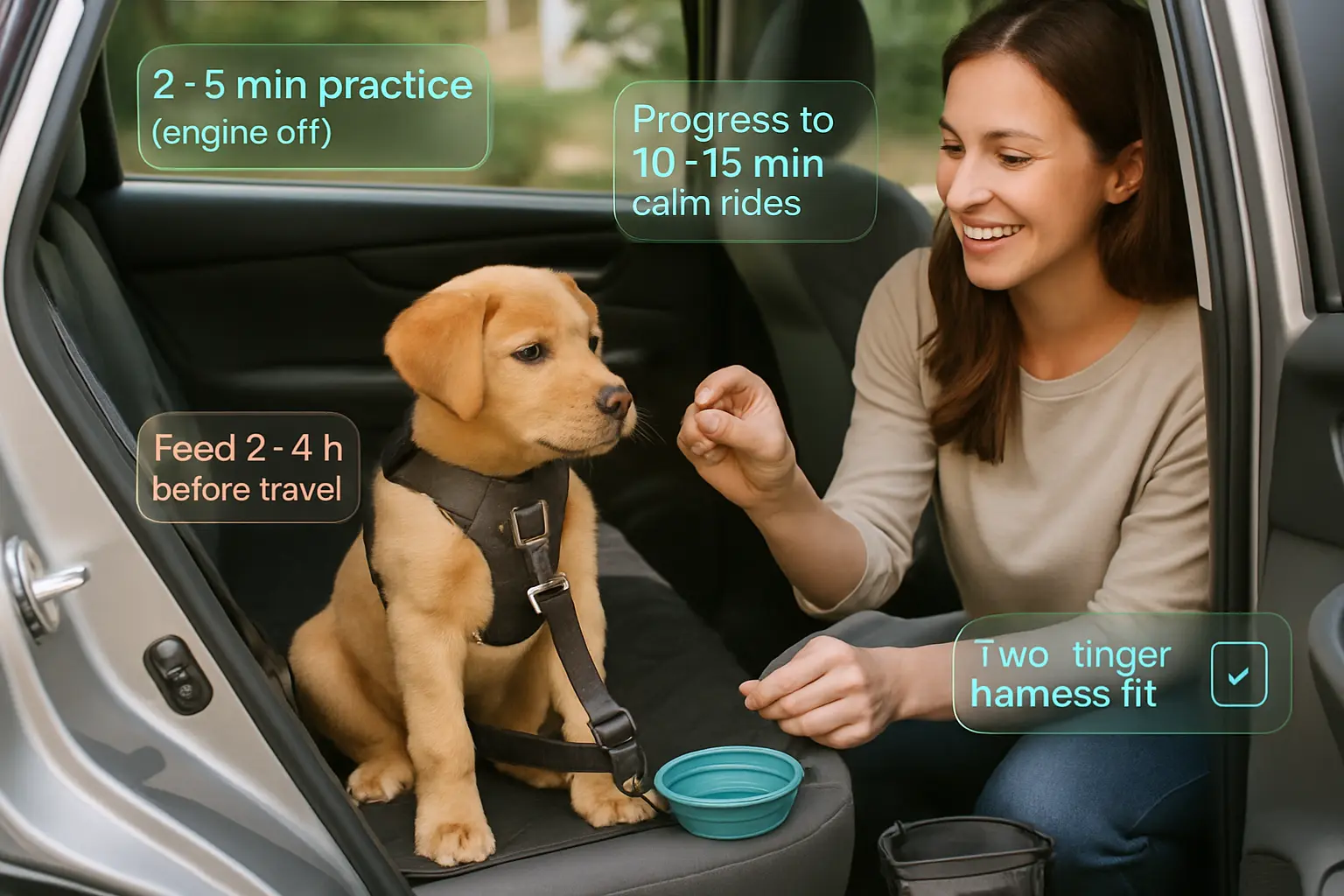
Puppies learn car manners through short, consistent sessions that build confidence. Start by teaching basic cues such as sit, stay and place away from the driver. Practice getting in and out calmly, then reward quiet behavior with high-value treats and brief praise. Use a properly fitted harness or a vehicle-specific seatbelt to keep the puppy secure and to prevent sudden falls or distracting movement. Measure the harness against the puppy before the trip and adjust straps for a snug, comfortable fit.
A gradual routine reduces fear. Begin with engine-off sessions, then progress to short drives around the block. Increase trip length only when the puppy remains relaxed. Avoid forcing entry; instead, coax the puppy with treats and toys. For owners troubleshooting stubborn or reluctant puppies, the guide on dog refusing to get into car offers practical steps to encourage willingness without stress. Keep sessions predictable: same harness, same spot in the car, consistent rewards. Regular practice makes longer trips manageable and safer for everyone.
Short, positive practice trips and reward-based acclimation
Short, frequent rides teach puppies that the car equals pleasant experiences. Begin with two- to five-minute sessions parked in a quiet area. Let the puppy explore the vehicle freely while offering treats for calm sniffing and sitting. Progress to very short drives that end at a fun destination, such as a yard or park, so the puppy links travel to positive outcomes.
Use a reward schedule that shifts from continuous treats to intermittent reinforcement. Initially, give treats every time the puppy behaves calmly. After several successful rides, give treats unpredictably to maintain obedience. Offer favored chew toys or a stuffed kong to occupy the puppy on longer trips. Avoid lengthy correction or loud reprimands; they create negative associations.
Consistency matters. Make practice trips part of daily routine until the puppy shows reliable calm. For additional behavior-focused strategies and natural calming options, consult the piece on 9 natural ways to remedy your dog’s travel anxiety. That resource pairs well with reward-based acclimation plans.
Addressing motion sickness and anxiety (meds, calming tools)
Recognize motion sickness signs: drooling, lip licking, yawning, whining, or a sudden lack of appetite. For recurring symptoms, schedule a veterinary consult. A vet can rule out medical causes and prescribe anti-nausea medication if needed. Veterinarians also recommend dosing schedules and provide safe options for puppies.
Nonprescription calming tools help many pups. A snug, compression-style wrap reduces nervous energy. Pheromone sprays or collars create a reassuring scent environment. Offer chew-safe distractions and freeze-dried treats to occupy attention during motion. Keep the cabin cool and ventilated; fresh air often eases nausea.
Timing matters. Avoid feeding a full meal two to four hours before travel. Give small amounts of water during stops. Use short practice drives to build tolerance rather than long, taxing trips from the outset. For practical motion-sickness strategies and product suggestions, see no more doggie dramas—how to make car rides enjoyable for your motion sick pup. Always follow a vet’s guidance before trying medications.
Items to pack: water, potty supplies, seat covers and vet info
Pack a compact travel kit dedicated to the puppy. Include these essentials:
- Collapsible water bowl and bottled water for short stops.
- Waste bags, a small roll of puppy pads, and an extra towel for accidents.
- Seat covers or waterproof hammock protectors to keep upholstery clean and provide traction.
- A secure travel harness or a seatbelt attachment rated for dogs.
- Leash, clipped ID tags, and a familiar toy to reduce stress.
- Basic first-aid items: bandage strips, antiseptic wipes, and any prescribed meds.
- Hard or digital copies of vaccination records and the nearest emergency vet contact.
Store the kit in an easy-to-reach tote and replenish supplies after each trip. For a broader list of travel gear and packing recommendations, consult the essential dog travel tips and gear for road trips guide. Pack the kit before every trip and confirm harness fit and paperwork during pre-trip checks.
Planning longer trips and handling emergencies
Longer journeys demand planning beyond a short errand. Schedule a pre-trip vet visit to confirm vaccinations, parasite prevention and fitness for travel. Store digital and paper copies of vaccination records, microchip number and the primary veterinarian’s contact. Map the route to include pet-friendly rest stops and nearby 24-hour veterinary clinics along the way. Pack a compact travel folder with medical records and a recent photo of the puppy for identification.
Allocate extra travel time for unscheduled stops and slow traffic. A flexible schedule reduces stress and gives time to address motion sickness or unexpected accidents. Bring several secure restraint options and alternate routes in case road closures occur. Keep emergency phone numbers and a list of local vets in the glove box and on a phone screenshot.
For practical travel gear and overall road-trip preparation, review Essential dog travel tips and gear for road trips. Prepare a departure checklist and place it where the driver can see it before leaving.
Timing breaks, feeding strategy and hydration on the road
Timing breaks preserves comfort and reduces accidents. Plan bathroom and stretch stops every two to three hours for most puppies. Shorter intervals suit very young pups under four months. Use pre-mapped rest areas or pet-friendly stops to avoid unsafe roadside exits.
Adopt a conservative feeding strategy. Offer small, light meals rather than full portions during travel. Avoid feeding within one to two hours before departure if the puppy gets car sick. Freshwater should remain available; use spill-proof travel bottles or a shallow dish during stops. Monitor drinking to prevent gulping and vomiting.
Carry absorbent pads and cleanup supplies in case of an accident. For practical cleanup and handling tips, see Dog poops in car. During breaks, exercise the puppy on leash to burn energy and encourage normal elimination before returning to the vehicle.
Temperature safety and why you should never leave a puppy alone
Temperature control ranks among the most urgent safety concerns. Puppies cannot regulate body temperature well. Cars can overheat or cool rapidly, creating life-threatening conditions. Maintain a comfortable cabin temperature and monitor the puppy continuously.
Recognize early signs of heat stress: excessive panting, drooling, weakness, disorientation, and bright red gums. Cold-risk signs include shivering, lethargy and slow movement. Never assume a cracked window provides enough airflow. Even mild sun on a warm day can raise interior temperatures quickly.
Never leave a puppy unattended in a vehicle, even for a minute. If a driver must step away, take the puppy along. If a puppy shows dangerous symptoms, move it to a shaded, cool area and contact a vet immediately. For context on panting and temperature signals, consult Why do dogs pant in the car?.
Creating an emergency kit and what to do after an incident
Assemble a compact, accessible emergency kit and store it in the car. Include: leash and sturdy harness, sterile gauze, adhesive tape, bandage roll, styptic powder, disposable gloves, antiseptic wipes, a digital thermometer, small blanket, bottled water, portable bowl, and recent photo plus vaccination info. Add a towel and disposable plastic bags for cleanup. Include an over-the-counter antihistamine only if a vet has approved its use and dosing.
After an incident, stop the vehicle safely and secure the puppy. Check airway, breathing and bleeding. Apply gentle pressure to control bleeding and wrap wounds lightly. If the puppy cannot move, stabilize the neck and spine and avoid unnecessary movement. Contact the primary veterinarian or the nearest emergency clinic and describe symptoms clearly.
When transport becomes necessary, follow safe lifting techniques to avoid further injury. For guidance on lifting and loading injured dogs, consult 5 steps to safely lift a large dog into a car. Keep the emergency kit visible and refresh supplies after any use.
Summary
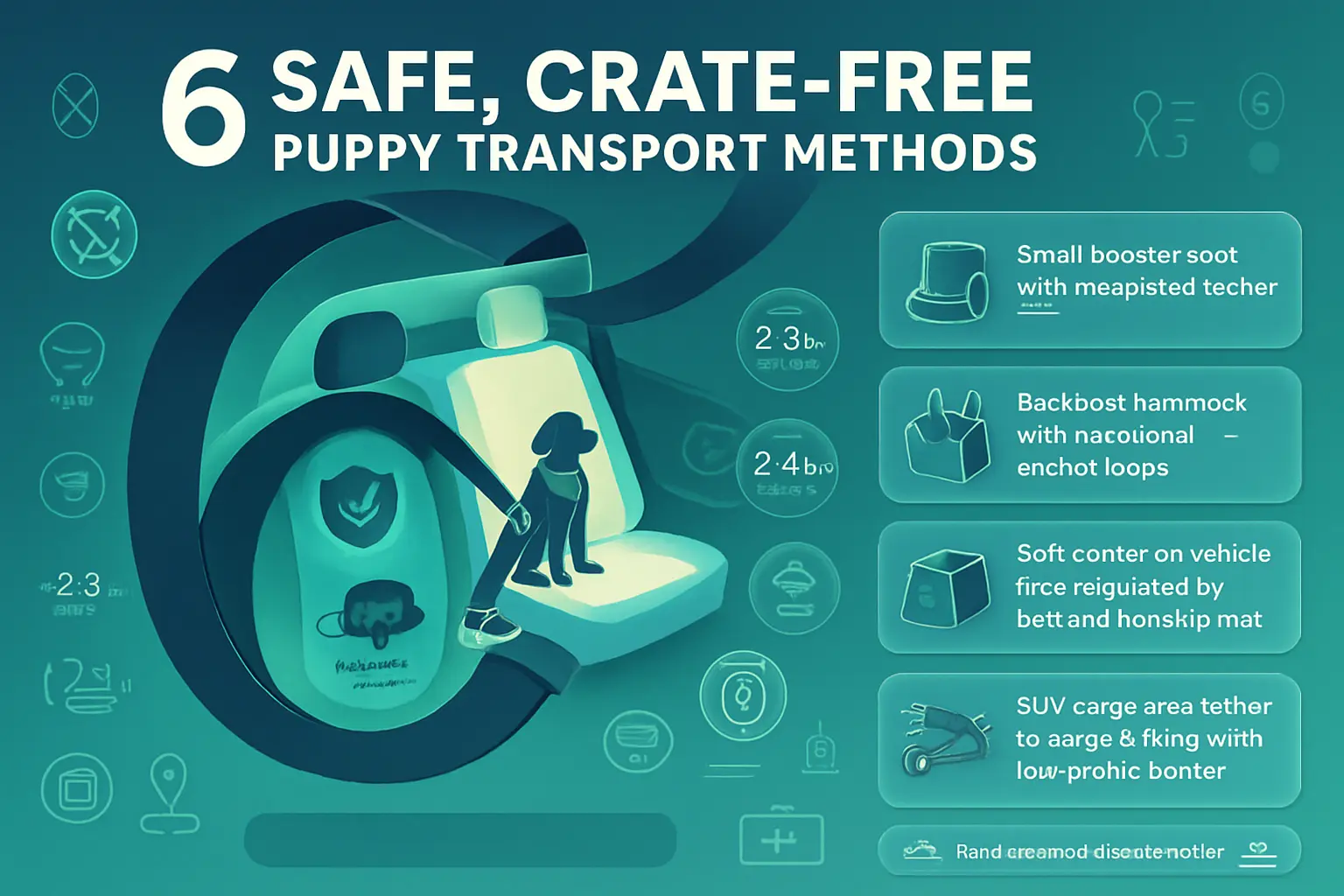
6 Safe Ways to Transport a Puppy in a Car Without a Crate equips owners with proven, non-crate options that keep a puppy secure in the back seat and reduce driver distraction. The guide compares crash-tested harnesses, boosters, hammocks, soft carriers on the floor, cargo-area setups, and hard-mounted systems—showing how to choose, fit, and anchor each method correctly.
Beyond equipment, it covers training for calm car manners, motion-sickness prevention, legal and insurance considerations, and long-trip planning. With clear fit checks, packing lists, and emergency steps, owners can prepare a puppy for short errands and longer road trips safely and confidently. CTA: Test-fit a crash-tested harness at home, run short practice rides, and verify local laws before the first long drive.
Key Takeaways
- Always restrain in the back seat: Airbags and laps are dangerous; attach only to a harness—never a collar.
- Prioritize crash-tested gear: Look for independent certification (e.g., CPS), solid hardware, and a short, correctly sized tether.
- Match method to the puppy and trip: Use harness-only or boosters for small pups, hammocks for stable platforms, soft carriers on the floor for nervous pups, cargo-area setups for larger breeds, and hard-mounted systems for maximum protection.
- Fit and install correctly: Use the two-finger rule, anchor to seatbelt paths or factory points, remove slack, and perform a tug test; recheck straps on longer rides.
- Train and prevent sickness: Build up with short, positive rides; feed lightly 2–4 hours before travel; keep the cabin cool; consult a vet if nausea persists.
- Plan for distance and emergencies: Schedule breaks every 2–3 hours, pack ID, water, first-aid and cleanup supplies, confirm local rules and insurance nuances, and never leave a puppy unattended in a vehicle.
FAQ
-
What is the safest non-crate way to transport a puppy?
A crash-tested travel harness secured to the rear-seat belt path or factory anchors is the safest general option. Small pups may benefit from a properly installed booster with an integrated tether attached to the harness.
-
How should a puppy travel harness fit and attach?
Measure chest girth, adjust for the two-finger rule at contact points, and clip to the harness D-ring on the back. Anchor to the seatbelt or lower anchors, remove excess slack, and perform a firm tug test before driving.
-
Why avoid the front seat and collar attachments?
Front airbags can seriously injure small dogs, and collars concentrate force on the neck in a sudden stop. A rear-seat harness setup spreads forces across the chest and keeps the puppy away from airbags.
-
How often should a puppy stop on longer trips?
Plan breaks every 2–3 hours, or more often for very young puppies. Offer water, potty time, and a brief walk before resuming travel.
-
What helps reduce motion sickness and anxiety?
Use short, positive practice rides, light meals 2–4 hours before departure, cool ventilation, and chew-safe distractions. If symptoms persist, ask a veterinarian about anti-nausea options and calming aids.

